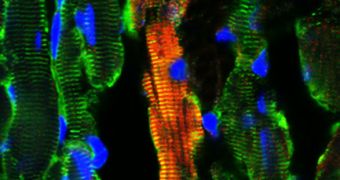Scientists recently discovered that stem cells in a thin layer around the heart can repair some of the damage produced by heart attacks. However, these repair cells need to be given what experts refer to as the proper biochemical motivation,
The beneficial cells are located on the outside of the heart muscle, organized in a thin layer that is almost not discernible from its surroundings. When they start differentiating, they can replace a small portion of the cells destroyed during heart attacks.
These dormant stem cells can apparently be awaken to fulfill their role by a small molecules, the protein hymosin beta-4. The discovery was made by University College London (UCL) British Heart Foundation researcher Paul Riley.
He was the leader of an international collaboration of experts, which reported on its findings in the JAune 8 online issue of the esteemed scientific journal Nature. The new study is the last in a string of researches meant to discover ways of making the heart heal itself.
Discovering the thin layer of cardiac stem cells finally puts a long-standing debate to rest. Until now, experts failed to discover any such cells in the layers of cell surrounding heart muscles. Evidence to their presence have been contradictory, and researchers argued over this for years.
“The notion that the heart can regenerate itself is very powerful,” says cardiac stem cell biologist, Deepak Srivastava, who was not a part of the new work. He is based at the University of California in San Francisco (UCSF) and the Gladstone Institute of Cardiovascular Disease.
The role of thymosin beta-4 was already known, experts say. In lab experiments conducted on mice, scientist showed some time ago that heart muscles have a higher chance of surviving than without the protein. Now, the UCL-led team evidenced a hidden aspect of the molecule's function.
The protein can only replace a small number of all the cells a heart attack usually damages. The healing layer can be found in a layer around the heart muscle called the epicardium, Science News reports.
“Even though it’s a small number, it’s still significant, because we didn’t think the heart could do this at all,” Srivastava explains. Interestingly, only mice that were given the protein-based drug before the induced heart attack showed cardiac cell regeneration.
The new findings contribute a great deal to an emerging school of thought in the field of medical research, which increasingly calls on experts to look for ways of fighting against diseases within the human body.

 14 DAY TRIAL //
14 DAY TRIAL //